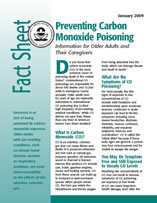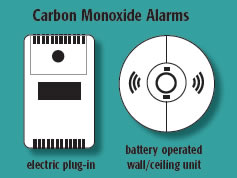Carbon Monoxide Poisoning Prevention
Do you know that carbon monoxide (CO) is the most common cause of poisoning death in the United States? Approximately 500 deaths and 15,000 visits to the emergency room occur annually due to unintentional CO poisoning. Older adults over 65 years of age are especially vulnerable to unintentional CO poisoning due to their high frequency of pre-existing medical conditions. While CO alarms can save lives, less than one third of American homes have them installed.
What is Carbon Monoxide?
Carbon monoxide, or CO, is an odorless, colorless gas that can cause illness and death. CO is produced whenever any fuel such as natural gas, propane, gasoline, oil, kerosene, wood, or charcoal is burned. Devices that produce CO include cars, boats, gasoline engines, stoves and heating systems. CO from these sources can build up in enclosed or semi-enclosed spaces.
What are the Symptoms of CO Poisoning?
For most people, the first signs of exposure to low concentrations of CO include mild headache and breathlessness upon moderate exercise. Continued or acute exposure can lead to flu-like symptoms including more severe headaches, dizziness, tiredness, nausea, confusion, irritability, and impaired judgment, memory and coordination. CO is called the "silent killer" because if these early signs are ignored, a person may lose consciousness and be unable to escape the danger.
How to Tell the Difference between CO Poisoning and the Flu
Since many of the symptoms of CO poisoning are similar to those of the flu, you may not think that CO poisoning could be the cause. Symptoms could be the result of CO poisoning when:
- You feel better when you are away from your home.
- More than one person in the home gets sick at the same time (it usually takes several days for the flu to pass from person to person).
- Family members who are most affected spend the most time in the home.
- Symptoms occur or get worse shortly after turning on a fuel-burning device or running a vehicle in an attached garage.
- Indoor pets also appear ill, exhibiting symptoms such as drowsiness and lethargy (human flu viruses are not transmitted to pets).
- You don’t have generalized aching, low-grade fever, or swollen lymph nodes (these are typical of a cold or flu).
To Prevent CO Poisoning I Can: [Remember ICANB]
- Install CO alarms near sleeping areas.
- Check heating systems and fuel-burning appliances annually.
- Avoid the use of non-vented combustion appliances
- Never burn fuels indoors except in devices such as stoves or furnaces that are made for safe use.
- Be Attentive to possible symptoms of CO poisoning.
Resources
Additional Resources:
Fact sheets:
You will need Adobe Reader to view some of the files on this page. See EPA's PDF page to learn more.
- English (PDF) (4pp, 382K)
Publication Number EPA-100-F-09-001 - Large Print: English (PDF) (7pp, 763K)
Publication Number - Arabic | العربية (PDF) (4pp, 3.2MB)
Publication Number EPA-100-F-09-011 - Armenian (PDF) (4pp, 815K)
Publication Number EPA-100-F-09-008 - Chinese Simplified |
 (PDF) (4pp, 739K)
(PDF) (4pp, 739K)
Publication Number EPA-100-F-09-029 - Chinese Traditional |
 (PDF) (4pp, 2MB)
(PDF) (4pp, 2MB)
Publication Number EPA-100-F-09-010 - French (PDF) (4pp, 388K)
Publication Number EPA-100-F-09-007 - Haitian-Creole | Kreyòl Ayisyen (PDF) (4pp, 214K)
Publication Number EPA-100-F-09-015 - Hindi | हिन्दी (PDF) (4pp, 629K)
Publication Number EPA-100-F-10-004 - Italian | Italiano (PDF) (4pp, 298K)
Publication Number EPA-100-F-09-006 - Japanese |
 (4 pp, 552K)
(4 pp, 552K)
Publication Number 100-F-11-002 - Korean |
 (PDF) (4pp, 814K)
(PDF) (4pp, 814K)
Publication Number EPA-100-F-09-012 - Polish | Polski (PDF) (4pp, 406K)
Publication Number EPA-100-F-09-014 - Portuguese (PDF) (4pp, 305K)
Publication Number EPA-100-F-09-004 - Russian | Русский (PDF) (4pp, 375K)
Publication Number EPA-100-F-09-013 - Spanish | Español (PDF) (4pp, 302K)
Publication Number EPA-100-F-09-005 - Tagalog (PDF) (4pp, 298K)
Publication Number EPA-100-F-09-034 - Thai | ภาษาไทย (PDF) (4 pp, 477K)
Publication Number EPA-100-F-09-018 - Vietnamese | Tiếng Việt (PDF) (4pp, 384K)
Publication Number EPA-100-F-09-009
![[logo] US EPA](https://cybercemetery.unt.edu/archive/oilspill/20121016191334im_/http://www.epa.gov/epafiles/images/logo_epaseal.gif)

